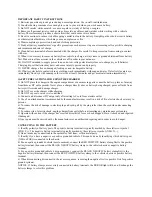
IMPORTANT SAFETY INSTRUCTIONS
1) Batteries generate explosive gases during normal operation. Use in well-ventilated area.
2) Consider having someone close enough to come to your aid when you work near a battery.
3) Do NOT smoke, strike a match, or cause a spark in vicinity of battery or engine.
4) Remove all personal jewelry, such as rings, bracelets, necklaces, and watches while working with a vehicle
battery. These items may produce a short-circuit that could cause severe burns.
5) Be extra cautious to reduce risk of dropping a metal tool onto the battery. It might spark or short-circuit a battery
or other electrical hardware which may cause an explosion or fire.
6) Wear complete eye protection, hand and clothing protection.
7) Study all battery manufacturer’s specific precautions such as removing or not removing cell caps while charging
and recommended rates of charge.
8) Clean battery terminals before connected with the charger. Be careful to keep corrosion from coming in contact
with eyes.
9) When it is necessary to remove a battery from vehicle to charge, always remove grounded terminal from battery
first. Make sure all accessories in the vehicle are off in order to prevent an arc.
10) It is NOT intended to supply power to an extra-low-voltage electrical system or to charge dry-cell batteries.
Charging dry-cell batteries may burst and cause injury to persons and property.
11) NEVER charge a frozen, damaged, leaking or non-rechargeable battery.
12) If battery electrolyte contacts skin or clothing, wash immediately with soap and water. If electrolyte enters eye,
immediately flood eye with running cold water for at least 15 minutes and get medical attention immediately.
SAFETY PRECAUTIONS FOR USING THE CHARGER
1) Do NOT place the charger in the engine compartment or near moving parts or near the battery; place as far away
from them as DC cable permits. Never place a charger directly above a battery being charged; gases or fluids from
battery will corrode and damage charger.
2) Do NOT cover the charger while charging.
3) Do NOT expose to rain or wet conditions.
4) Connect and disconnect DC output only after setting AC cord from electric outlet.
5) Use of an attachment not recommended by the manufacturer may result in a risk of fire, electric shock or injury to
persons.
6) To reduce the risk of damage to electric plug and cord, pull by the plug rather than the cord when disconnecting
charger.
7) To reduce risk of electric shock, unplug charger from outlet before attempting any maintenance or cleaning.
8) Operate with caution if the charger has received direct hit of force or been dropped. Have it checked and repaired
if damaged.
9) Any repair must be carried out by the manufacturer or an authorized repair agent in order to avoid danger.
CONNECTING TO THE BATTERY
1) Identify polarity of battery posts. The positive battery terminal is typically marked by these letters or symbol
(POS, P, +). The negative battery terminal is typically marked by these letters or symbol (NEG, N, -).
2) Do not make any connections to the carburetor, fuel lines, or thin metal parts.
3) Identify if you have a negative or positive grounded vehicle. This can be done by identifying which battery post
(NEG or POS) is connected to the chassis.
4) For a negative grounded vehicle (most common): connect the RED POSITIVE battery clamp first to the positive
battery terminal, then connect the BLACK NEGATIV battery clamp to the vehicle chassis or negative battery
terminal.
5) For a positive grounded vehicle (very uncommon): connect the BLACK NEGATIV battery clamp first to the
negative battery terminal, then connect the RED POSITIVE battery clamp to the vehicle chassis or positive battery
terminal.
6) When disconnecting, disconnect in the reverse sequence, removing the negative first (or positive first for positive
ground systems).
NOTICE: If battery clamps are reversely connected to battery terminals, the ERROR light will be on. Exchange the
battery clamps to solve this problem.























